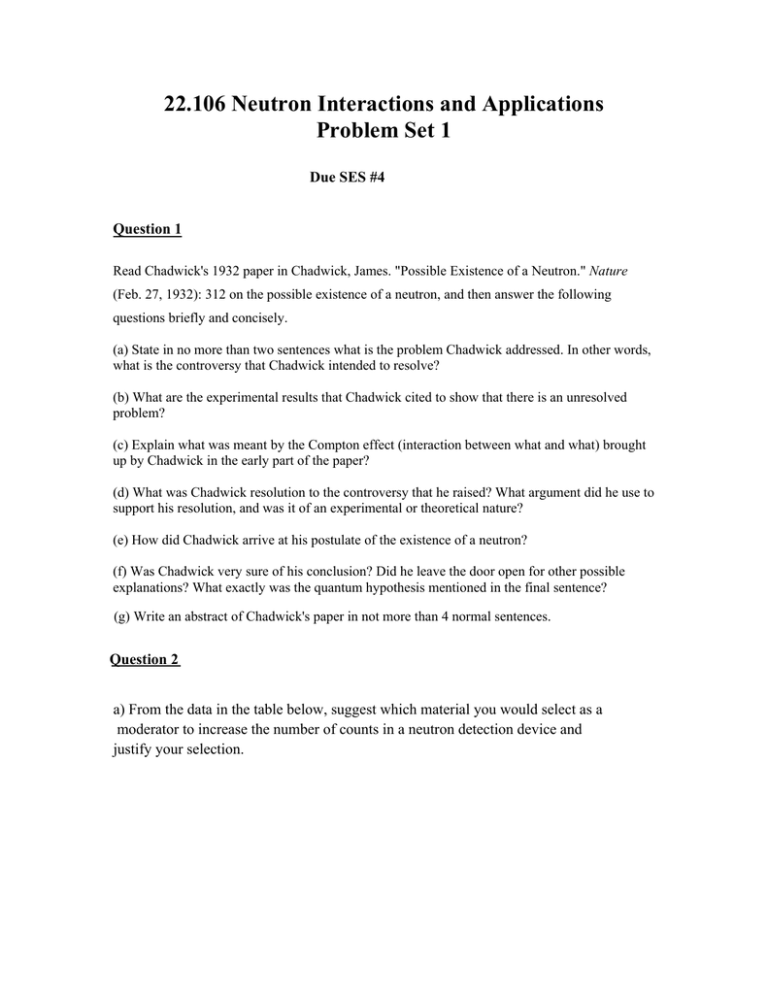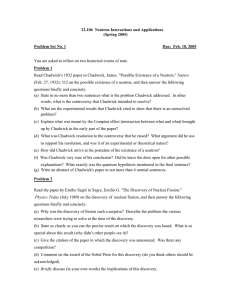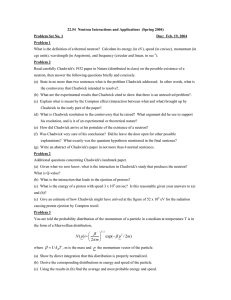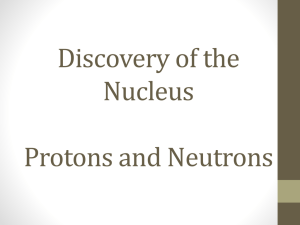22.106 Neutron Interactions and Applications Problem Set 1 Due SES #4
advertisement

22.106 Neutron Interactions and Applications Problem Set 1 Due SES #4 Question 1 Read Chadwick's 1932 paper in Chadwick, James. "Possible Existence of a Neutron." Nature (Feb. 27, 1932): 312 on the possible existence of a neutron, and then answer the following questions briefly and concisely. (a) State in no more than two sentences what is the problem Chadwick addressed. In other words, what is the controversy that Chadwick intended to resolve? (b) What are the experimental results that Chadwick cited to show that there is an unresolved problem? (c) Explain what was meant by the Compton effect (interaction between what and what) brought up by Chadwick in the early part of the paper? (d) What was Chadwick resolution to the controversy that he raised? What argument did he use to support his resolution, and was it of an experimental or theoretical nature? (e) How did Chadwick arrive at his postulate of the existence of a neutron? (f) Was Chadwick very sure of his conclusion? Did he leave the door open for other possible explanations? What exactly was the quantum hypothesis mentioned in the final sentence? (g) Write an abstract of Chadwick's paper in not more than 4 normal sentences. Question 2 a) From the data in the table below, suggest which material you would select as a moderator to increase the number of counts in a neutron detection device and justify your selection. Table I Material A B C ξ 0.7 0.5 0.25 ΣS (cm-1) 2 5 10 ΣA (cm-1) 1 0.2 0.05 ξ: Average logarithmic energy decrement ΣS: Macroscopic scattering cross-section ΣA: Macroscopic absorption cross-section b) Explain the need for a moderator in the development of a detection device for fast neutrons. Question 3 A neutron ground probe that uses 1 MeV neutrons is used to detect the presence of oil in limestone (CaCO3). The ground beneath the probe has been compacted non-uniformly over the years. This density change can be estimated by the following linear relation: p(x) = 2.2 (1 + 0.01x), where x is in meters and ρ(x) is in g/cm3. Table I: Nuclear data of limestone Microscopic total x.s. at 1 MeV (in barns) Ca 1.14 C 2.58 O 8.22 a) Calculate the probability of neutrons reaching a depth of 200 meters. b) If more neutrons are needed to reach 200 meters to obtain significant results, suggest two possibilities for increasing the number of neutrons. Question 4 Read the Cruzate et al paper on Bonner sphere Spectrometer. a) Discuss the limitations of experimentation in determining the response matrix data. b) Discuss the benefits of modeling and simulation in this context. c) A mono-energetic neutron source is detected by a system of Bonner spheres with response matrix of Figure 4. Using the data provided below, determine the neutron energy of the source. Response relative to 8” sphere 2” 0.32 3” 1.18 5” 2.09 8” 1.00 10” 0.45 d) Explain how this technique would be used to determine the neutron spectrum of a distributed energy source. MIT OpenCourseWare http://ocw.mit.edu 22.106 Neutron �� Interactions and Applications Spring 2010 For information about citing these materials or our Terms of Use, visit: http://ocw.mit.edu/terms.







